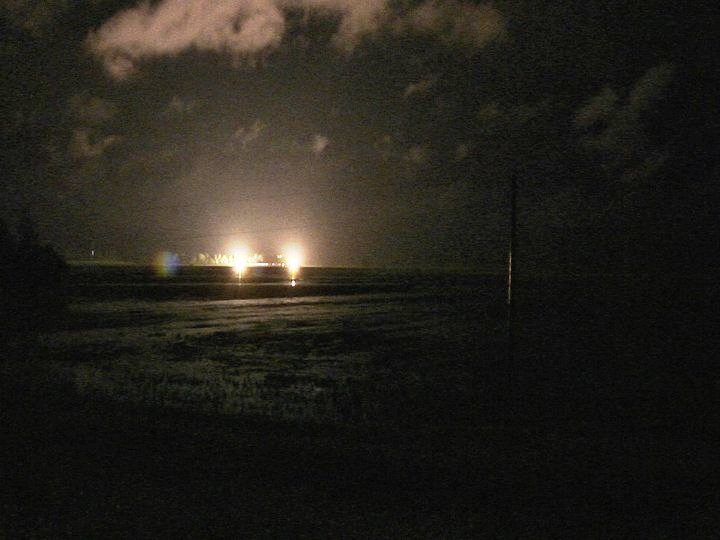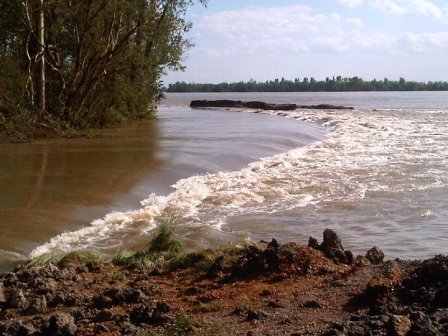Part 1 - Blowing the Levee Round One
 Raging rain and water framed the blackness of the night as two massive fireballs ripped high into the black sky over the Birds Point Levee just south of Cairo, Illinois. Raging rain and water framed the blackness of the night as two massive fireballs ripped high into the black sky over the Birds Point Levee just south of Cairo, Illinois.
The US Army Corps of Engineers had tossed the coin on who to save and made the decision to blow the Levee. Using high explosives, the Corps had made the decision to flood over 130,000 acres of prime farm land in Mississippi County, Missouri in order to save eight communities in Kentucky, Illinois, and Tennessee.
According to the Wall Street Journal’s report on the event, “The Corps pumped an aluminized slurry blasting agent into three 11,000 foot pipes built into the top of the levee, said Corps spokesman Jim Pogue. The Corps then wired up a series of T3 explosives to explode the agent inside the pipes. The goal wasn’t to destroy the Levee, but to fracture it, allowing the water to break through and flow into the floodway. The blast went off Monday, about 10 p.m. local time.”
This was to be the first step in a three step plan. After this initial explosion, another two would be charged along the length of the levee.
Fighting for the Town
As the Levee was being blown, 20 miles down river at the inland port of Hickman Kentucky, over 300 volunteers worked around the clock to fill and position sandbags against the rising waters. A mixture of local citizens, high school students, government workers and Fulton County Detention Center inmates filled thousands of sandbags. They were working against not only the river but the fact that along a 17 mile levee and flood wall, old age and neglect had allowed the floodwall to be weakened in many strategic spots.
Most of the buildings being protected by the aged floodwall had already been breached by old age and structural damage from earthquakes and ground slippage years ago. Of the 20 plus brick buildings in the downtown danger zone, only 5 were occupied by retail or government offices. Years ago, most of Hickman’s economic base had deserted the river’s edge for higher ground on top of the bluff.
Still, the land next to the levee and floodwall was the historic and cultural heritage center for Hickman. It was worth fighting for. More volunteers were brought in to save the city.
They fought to keep ahead of the rising waters even as the massive floodwall gates had to be reinforced with railroad crossties. Water poured through cracks in the gate. Concern was mounting that the city was lost. A last minute effort was made to sandbag and protect a major water system pumping station near the high school. The fear was if the water treatment plant was compromised by river water, the entire city would have to be evacuated.
Monster Sand Boils
During these first hours of fighting back against the rising river waters, Mother Nature threw the fragile defenders a new curveball, sand boils. These are rather nasty creatures of quick sand traps that form within seconds. Underground water seeps under the levee and under great pressure from the weight of the wall of flooding waters, sand and water explode upward. These explosions are like small geysers going off. Sometimes, the force of the explosion would travel 10 to 25 ft into the air.
Sand boils started to appear on Wednesday April 27, 2011. At first, only a handful could be located. By the next day, some 14 large sand boils were being tracked along the dry side of the levee. Several of the new sand boils were large, being over 15 to 20 feet in diameter. Each sand boil became a pool of liquid sand with almost no bottom to them.
By the morning of the following day, April 29th, 14 large sand boils had been marked with a ring of sandbags and 100 sand boils had been marked for observation. With each new day, the land side of the levee was turning into liquid sand.
Blowing the Levee Round Two
After the first blast went off at Birds Point, Missouri, several sections of the bluff wall in Hickman collapsed. A new fear for the officials of Hickman: What will happen to bluff redevelopment sections after the full force of the second blast is felt? The first blast was 20 miles away, by river travel. Windows were blown out of homes in Kentucky. The boom was heard up to 30 miles away in Cayce and Fulton, Kentucky.
The second blast went off at 1 p.m. on Tuesday.
The third blast is scheduled for New Madrid, Missouri, only 10 miles away from the Hickman bluffs. Kentucky officials are worried that a blast of this magnitude could have serious impact to Hickman.

After the horrific flood of 1927, the US Army Corps Engineers developed a special high risk plan to divert high flood waters of the Mississippi River down stream. This plan involved the design of a large spill way to be used in order to relive pressure off of the flood stage levels from the Mississippi and Ohio Rivers. This floodway would become a pre
ssure valve release point.
According to the Wall Street Journal report on this event, ”The Corps breaching of the levee activated the floodway, which is diverting water for 35 miles before returning it to the Mississippi at New Madrid, Mo. The floodway is one of four developed by the Corps under a plan to the aftermath of the great flood of 1927. It consists of a mix of public and private lands, much of which have easements granting the Corps the right to run water through.”
Managing the Beast
If all goes according to plan, the Corps will have created a fast flowing floodway of water moving at 360,000 cubic feet a second. This will create a new lake flowing next to the main river channel that will cover over 133,000 acres at a depth of 10 to 15 feet. On the map, this floodway will start at just south of Cairo, Illinois at Birds Point, Missouri and end at New Madrid, Missouri.
The flood stages at Smithland, Ky. Paducah, Ky. and Cairo, Illinois have already started to drop rapidly. Pressure has been taken off of the Kentucky Dam area as well. In some strange case for success, the Corps has proven that man can, if only for a short brief time, master the raging Mississippi River.
Corps End Game Defines Future Urban and Rural Policy
Now, after the initial stabilization of the flooding threat comes the longer term questions of (1) who will pay for the damages, (2) will this action become a new solution to saving urban America from natural disasters, (3) and what is to become of rural America in and after major disasters?
These questions will more than likely become part of the legal and public policy debate over the use of federal power to condemn private property during times of great natural disasters. These questions will also help frame the debate over the future of rural America in relationships to new mega city states in Mid America.
|


 Raging rain and water framed the blackness of the night as two massive fireballs ripped high into the black sky over the Birds Point Levee just south of Cairo, Illinois.
Raging rain and water framed the blackness of the night as two massive fireballs ripped high into the black sky over the Birds Point Levee just south of Cairo, Illinois. 




